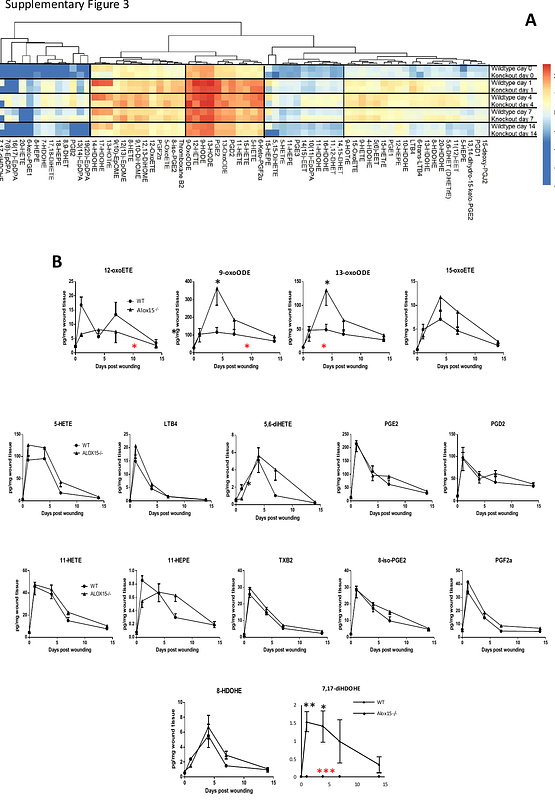12/15-Lipoxygenase orchestrates murine wound healing via PPARg-activating oxylipins acting holistically to dampen inflammation.

12/15-Lipoxygenase orchestrates murine wound healing via PPARg-activating oxylipins acting holistically to dampen inflammation.
Thomas, C.; Tyrrell, V.; Burston, J.; Johnson, S.; Aldrovandi, M.; Alvarez Jarreta, J.; Inglis, R.; Leonard, A.; Fice, L.; Costales, J.; Carobbio, S.; Vidal-Puig, A.; Protty, M.; Guy, C.; Andrews, R.; Szomolay, B.; Cossins, B.; Cardus Figueras, A.; Jones, S. A.; O'Donnell, V.
Abstract12/15-lipoxygenase (12/15-LOX, Alox15) generates bioactive oxygenated lipids during inflammation, however its homeostatic role(s) in normal healing are unclear. Here, the role of 12/15-LOX in resolving skin wounds was elucidated, focusing on how its lipids act together in physiologically relevant amounts. In mice, wounding caused acute appearance of 12/15-LOX-expressing macrophages and stem cells, coupled to early generation of ~12 monohydroxy-oxylipins and enzymatically oxygenated phospholipids (eoxPL). Alox15 deletion increased a-smooth muscle actin, collagen deposition, stem cell/fibroblast proliferation, IL6/pSTAT3, pSMAD3, and IFN-{gamma} levels. Conversely, CD206 expression, F480+ cells, MMP9 and MMP2 activities were reduced. Alox15-/- skin was deficient in PPARg/adiponectin activity. Furthermore, while pro-inflammatory genes were upregulated as normal during wounding, many including Il6, Il1b, ccl4, Cd14, Cd274, Clec4d, Clec4e, Csf3, and Cxcl2 failed to revert to baseline during healing, indicating disruption of an anti-inflammatory brake. Reconstituting Alox15-/- wounds with a physiological mixture of Alox15-derived primary oxylipins generated by healing wounds restored MMP and dampened collagen deposition. The oxylipin mixture activated PPARg in vitro, while in vivo, the PPARg co-activator, Helz2, was significantly upregulated. Additional inflammatory and proliferative gene networks impacted by Alox15-/- included Elf4, Cebpb and Tcf3, with many of their associated genes significantly dysregulated. In summary, the impact of 12/15-LOX is ascribed to the deficiency of abundantly generated monohydroxy oxylipins acting together via PPARg/adiponectin. The identification of multiple gene alterations reveals several new targets for treatment of non-healing wounds. Our studies demonstrate that abundant 12/15-LOX oxylipins act together, dampening inflammation in vivo, revealing a need to consider lipid signaling holistically.